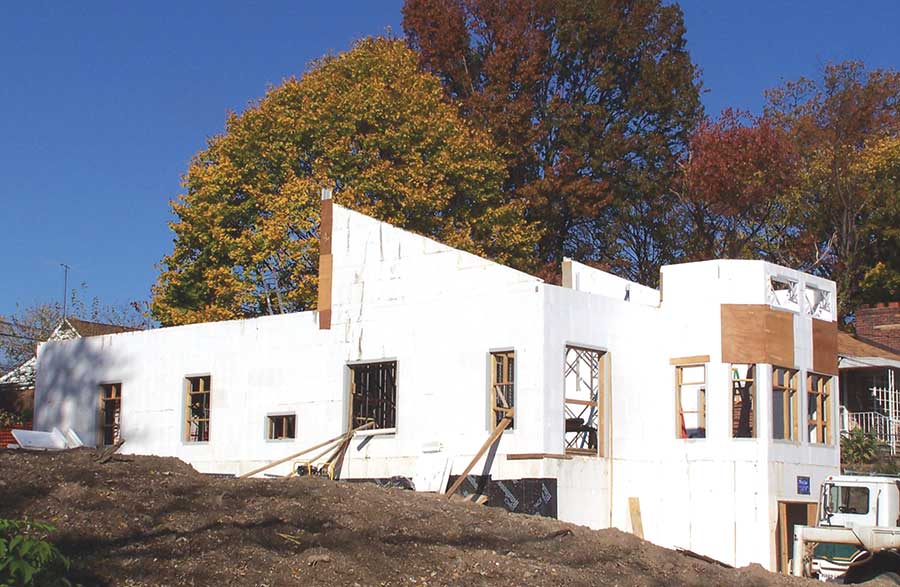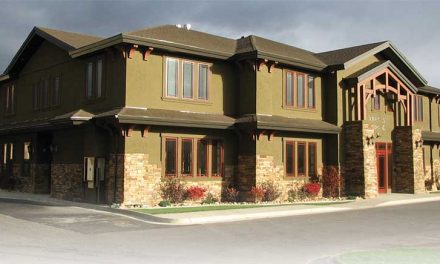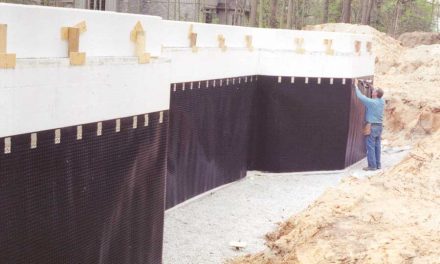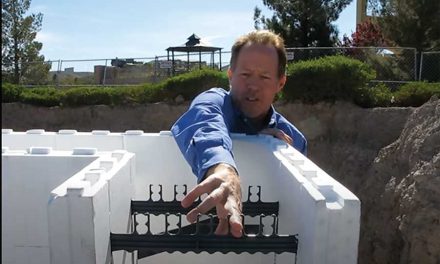The BASF zero-energy house, built with PolySteel ICFs, achieved a platinum-level LEED certification, the highest rating awarded by the U.S. Green Building Council.
There’s little doubt that green building is a major trend in the construction market these days. A quick look at the numbers shows how big the trend has become:
The U.S. Green Building Council (USGBC) now has more than 8,000 member organizations and 91,000 individual members. The number of LEED-accredited professionals has increased from a few dozen in 2001 to nearly 36,000 currently.
The USGBC website claims that “in the past four years, USGBC’s membership has tripled, over half a billion square feet of building space is participating in the LEED rating system, and the annual U.S. market in green building products and services has grown to $7 billion.”
The National Association of Home Builders (NAHB) reports similar growth. Twelve state and local associations have launched voluntary green building programs, with another dozen on the way.
This exploding demand for green products is good news for the ICF industry. No building system is better positioned to capitalize on the green building trend.
For instance, in the popular LEED program, ICFs can easily contribute 20 of the 26 points needed for certification.
Architects and contractors familiar with ICFs may enjoy a significant advantage when bidding on publicly owned building projects, since an increasing number of municipalities require that these be LEED-certified.
Quad-Lock Building Systems reports, “At least 10 states have adopted LEED standards for new construction (Arizona, California, Maine, Michigan, New Jersey, New York, Oregon, Pennsylvania, Washington, and Virginia.)”
Most LEED-certified buildings are new commercial projects, and are rated under the widely accepted LEED-NC guidelines. The USGBC rolled out a pilot version of LEED-Homes in August of 2005 for residential construction, which is less universally accepted. (See sidebar on pg. 14).
Even if you’re not trying to achieve LEED certification, ICFs contribute to sustainable building practices in at least five different ways. First, they reduce heating and cooling costs by up to 80%, reducing the “carbon footprint” of the structure over the life of the building. Second, they are a recycled and/or recyclable product. Third, because of their tightness and thermal mass, and because they contain no VOCs, ICF walls will improve indoor air quality. Fourth, the forms and the concrete that fills them are usually manufactured locally, reducing the pollution and energy involved with long-distance transportation. Lastly, the durability and long life cycle of ICF buildings means it can outlast two or three conventionally built structures.
ICFs and LEED
Here’s a breakdown of how those qualities function in LEED certification:
“LEED is a point system or standard of measurement to determine how ‘green’ a building is,” explains a fact sheet published by Reward Wall Systems. “All components of the building are evaluated to determine the LEED points. The whole building approach encourages an integrated design and construction process to achieve the highest level of sustainability, energy efficiency and resource economy.”
The LEED-NC rating system has five main credit categories:
1. Sustainable Sites (14 points)
2. Water Efficiency (5 points)
3. Energy and Atmosphere (17 points)
4. Materials Resources (13 points)
5. Indoor Environmental Quality (15)
Up to 5 extra credit points can be earned for items like durability, sound attenuation, and having a LEED Accredited Professional on the project team.
There is a maximum of 69 attainable points (70 in Canadian LEED), although a project only needs 26 to be certified. A platinum level project must earn 52 points or more.
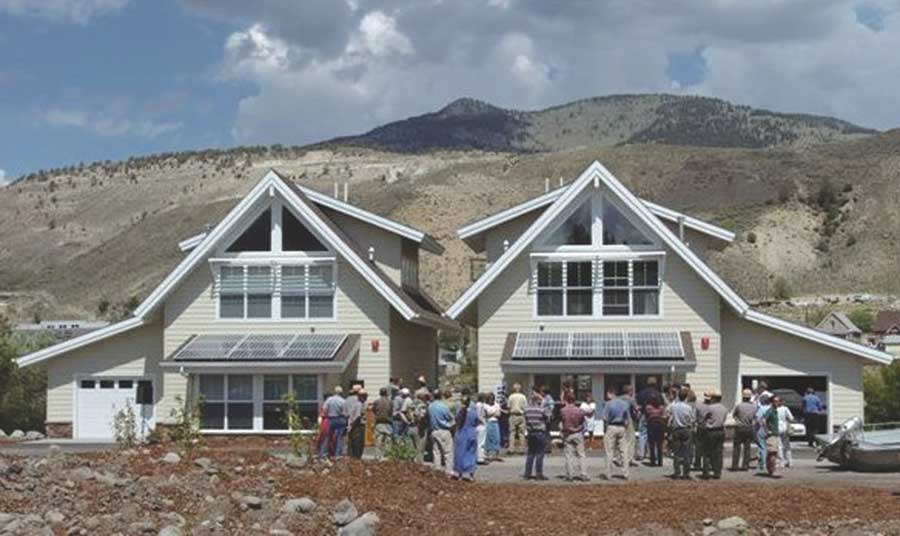
These two homes for Yellowstone National Park employees used Quad-Lock ICFs for the walls, with an R-Value three times what a standard wood-frame wall would be. They were the first LEED-certified homes in Montana.
Sustainable Site Credit: Designed to limit site disturbances, ICFs can contribute slightly. A recent Tech Sheet from the ICFA explains “ICF construction can help reduce impact to a construction site, as bracing is typically erected in the inside of the wall, with limited construction activity around the perimeter.”
Energy and Atmosphere: “If a building is designed… to achieve 35% energy savings, 8 points are awarded; if performance is 42% or better, 10 points are awarded,” explains a brochure from American PolySteel. ICF construction can typically reduce heating and cooling costs by more than 50%.
Materials: ICFs can contribute up to six points in this category. Projects get one point if 50% of waste is diverted from the landfill, two points if 75% is recycled. Not only are ICFs a low-waste building method, but the wall system is 100% recyclable: the foam, the ties, the concrete, the rebar.
Two more points can be earned by using recycled materials. Many forms used recycled materials in the ties, and the recycled steel in the rebar counts as well. Another option is to use fly ash (which is considered 100% post-consumer waste) in the concrete, or use crushed concrete as the aggregate.
The final two points in this category come from using local materials. One point if 10% of the materials is extracted and manufactured within 500 miles; both points if 20% is local. Most ICF brands will meet this requirement, and the gravel and ready-mixed concrete qualifies as well.
Indoor Environmental Quality: ICF walls help in this category by eliminating VOCs, improving thermal stability, and providing a tight building envelope, which helps regulate indoor humidity and temperature.
Extra Credit Points: Possible contributions in this area
include sound dampening from urban noise, the long life cycle of the building, the resistance to mold, mildew, and insects, and the extraordinary safety that ICFs provide in extreme weather and natural disasters. At least one ICF manufacturer, Quad-Lock, has a LEED-accredited professional on staff, which contributes another point, but also makes designing LEED-approved ICF buildings that much simpler.
Other LEED Programs
The preliminary scoring system for LEED-Homes is quite similar to that of LEED-NC. American PolySteel has published a fact sheet explaining how ICFs work with the new system. It claims that the PolySteel ICF can contribute up to 34 points in the LEED-H system, far more than the 30 required to be LEED-certified.
The USGBC announced in February that they are currently developing a LEED-Neighborhood program, and are seeking pilot projects to participate. (See story on p. 9 for additional details.) They also have specialized LEED certification for schools, retail buildings, remodel projects, and exterior building envelopes.
Costs
Regardless of whether the project team is striving for LEED certification or not, it’s clear that ICFs make a significant contribution to sustainable or “green” construction. At the GreenBuild show, held last November in Denver, Colo., one of the master speakers had a graph which illustrated the average construction cost of more than 30 commercial structures. As expected, they fell along a typical bell-shaped curve. Some of the lines were green, indicating they had been LEED certified. The remarkable part was that the green bars were seemingly randomly spaced throughout the graph.
“Building green simply doesn’t add additional costs,” he explained. “People need to get past the idea that ‘sustainable’ is just another added, costly benefit.”
Resources:
American PolySteel: “PolySteel Contributes to LEED-NC Certification”
American PolySteel: “PolySteel Contributes to LEED-H Certification”
Insulating Concrete Forms Association: “ICF Points to LEED”
Quad-Lock Building Systems “Quad-Lock a LEEDer in
Green Building”
Quad-Lock Building Systems “LEED-Accredited Professional on Staff”
Reward Wall Systems: “Green Building and LEED”
ICC vs. LEED
While the USGBC’s LEED-certification program is industry standard for commercial construction, the situation is less clear in the residential sector.
A LEED-Homes program was announced in late 2005, but the test period has stretched to several years, and isn’t expected to conclude until this spring. The USGBC website states they hope to publicly launch the LEED-H rating system by this August.
In the meantime, several other organizations have stepped forward to fill the void. Perhaps the most influential is the recently announced collaboration of the NAHB and ICC.
In February, these two organizations, likely the two most influential groups in residential construction, announced they are working to create their own residential green
building standard.
The National Association of Home Builders (NAHB) has more than 235,000 members, and will build more than 80% of new homes in 2007. Known as “the voice of the housing industry,” NAHB is affiliated with more than 800 state and local home builders associations around the country.
The International Code Council is equally powerful. The ICC develops the codes used to construct residential and commercial buildings—including homes and schools—throughout most of the United States.
NAHB President David Pressly called the collaboration “a resounding vote of confidence,” and noted that the NAHB Model Green Home Building Guidelines (published in 2005) is now a nationally recognized green building certification tool. It forms the basis of more than 15 state and local green building programs around the country.”
“NAHB members have proven that a voluntary, region-specific, flexible program can be both truly green and also allow for innovation,” he says.
LEED-H, on the other hand, is going strong, too. USGBC reports that “more than 200 builders representing 1,600 homes across the U.S. are participating in the pilot program, and 26 homes have already been LEED certified.”
One major difference between the programs is that the NAHB program allows for regional variations.
Pressly says NAHB members predict green building is the future of construction. “We surveyed our members a year ago,” he says, “and 92% of them said they would move to green building because ‘it’s the right thing to do.’ ”
ICC CEO Rick Weiland adds, “Green technology is going to play an important role in our collective future—not just in the United States but around the world.”

